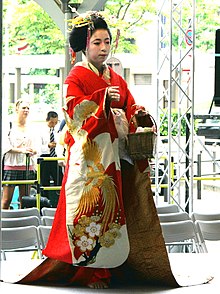Tayū
This article needs additional citations for verification. |

The Tayū are the highest class of traditional entertainers in Japan, outranking both the geisha and the oiran. They are required to be highly accomplished in numerous arts, such as chadō, kōdō, kadō, shodō, poetry, dance, singing, playing of traditional instruments and even martial arts. Unlikely some other classes of entertainers, they never engaged in sex work.
History
The tayū differ from the geisha by the social class of their customers. The tayū catered for the very highest echelons of society, including the highest nobility and the imperial court. They were recognised as a group in the beginning of the Edo period. Due to the limited size of their clientele they were never numerous. During their peak there were approximately 40 tayū working in Kyoto in the Shimabara district. Today, there are still a handful of tayū left in Kyoto, and their art is endangered.
The most famous tayū in history ware the Yoshino Tayū (吉野太夫), who lived in the 17th century. Trained from the age of 7, she quickly mastered the many arts required. She made her debut at the age of 14 and immediately became a sensation. According to the tradition she entranced all of her guests and, it's said, even drove some mad, with her beauty, skill and erudition. Yoshino Tayū in buried in the Jōshō-ji temple in Kyoto. Every year on the second Sunday in April, near the anniversary of her death, there is a procession of tayū to the temple, where a ceremoly is held.
Appearance
While entertaining, the tayū wear an elaborate kimono and hair ornaments weighing more than 2 kg. Unlike the oiran and the geisha, they do not use wigs but their own hair, which needs to be very long for the traditional elaborate coiffures. They wear white face makeup and blacken their teeth. The tayū is accompanied by an older female attendant and two kamuros, young girls wearing red livery bearing the tayū's name.
When outdoors the tayū wear distinctive extremely high platform sandals, which require a special mode of walking in order to look elegant, and also an attendant for support. This and many other aspects of the tayū's appearance were copied by the oiran, most notably in the oiran walk, a procession where the oiran processes to meet a customer.
See also
